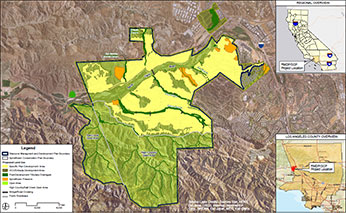Project Re-Approval and Certification of the Final Additional Environmental Analysis on Remand from the California Supreme Court (SCH No. 2000011025)
 Development Location Map
Development Location Map
Click image to enlarge
The California Department of Fish and Wildlife (CDFW) is pleased to announce the release of the Final Additional Environmental Analysis (AEA) and its re-approval of the Newhall Ranch Resource Management and Development Plan and Spineflower Conservation Plan (RMDP/SCP). Project re-approval comes after corrective environmental review under the California Environmental Quality Act (CEQA) following the California Supreme Court decision in Center for Biological Diversity v California Dept. of Fish and Wildlife (2015) 62 Cal.4th 204. CDFW approved the project originally in December 2010 after, among other things, preparing and certifying an environmental impact report (EIR) (SCH No. 2000011025). In 2015 in related litigation the Supreme Court identified two issues in need of further attention by CDFW. The Court first directed CDFW to revisit its 2010 determination that the project’s greenhouse gas (GHG) emissions would not be significant under CEQA. The Court held, second, that two mitigation measures approved by CDFW authorizing, if necessary, collection and relocation of stranded fish during in-water construction activity violated protections afforded species designated as “fully protected” under the Fish and Game Code.
CDFW’s decision to certify the Final AEA and re-approve the project follow a public environmental review effort focused on potential environmental impacts that might occur as a result of project modifications proposed by The Newhall Land and Farming Company (Newhall) to address the two issues identified by the Supreme Court. First as to GHG, Newhall developed a suite of thirteen measures in a detailed reduction plan to achieve “Net Zero Emissions” for the project, thereby offsetting 100% of the project’s GHG emissions. Relying on technical input from the California Air Resources Board (CARB) CDFW has determined as a lead agency that the project’s GHG emissions will not be significant under CEQA.
As to the collection and relocation measures addressed by the Supreme Court, Newhall proposed project modifications to obviate any need for the two measures originally approved by CDFW in 2010. Specifically, Newhall has proposed changes to the timing and construction methods for project bridges and bank stabilization infrastructure that will avoid all water contact during the construction of those facilities. With the “no water contact” approach to construction and minimal, less impacting related changes to the previously approved footprint of the bridges and bank stabilization infrastructure CDFW has determined the two collection and relocation measures addressed by the Supreme Court are no longer necessary. CDFW has determined the project as modified can be implemented consistent with the Fish and Game Code.
For an Accessible Version of the documents listed below (ZIP), download and open the ZIP folder, and open the "Index" file.
Documents